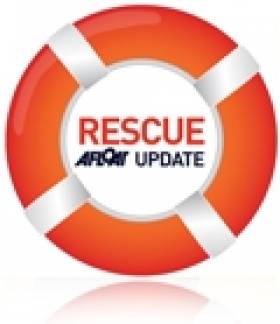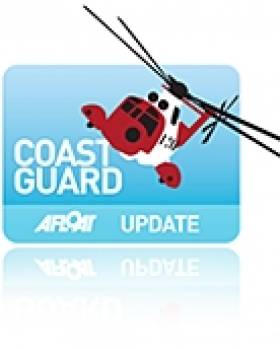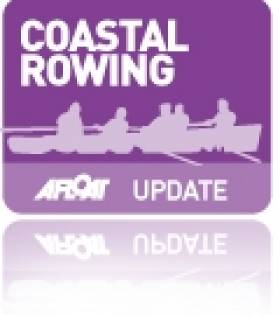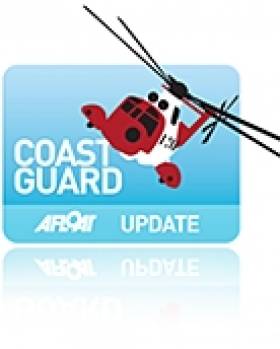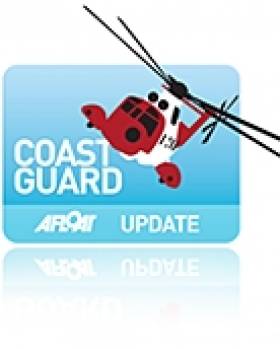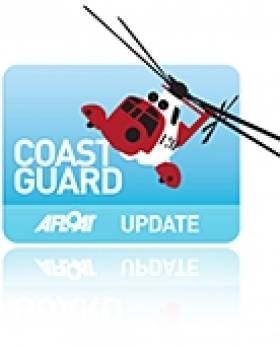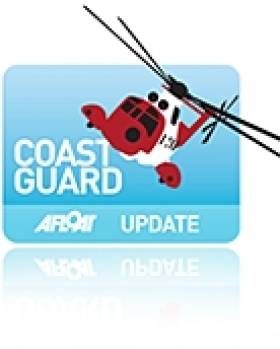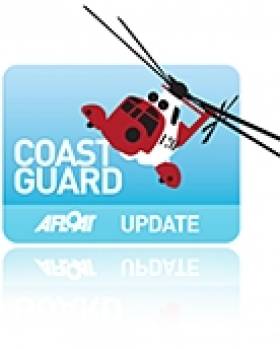Displaying items by tag: Coastguard
Rescue Alert Over Trawler Mayday in Irish Sea
The News & Star reports that RNLI Workington responded to the fishermen's mayday call along with Maryport's coastguard and inshore rescue team.
Engline failure is being blamed for the incident, which occurred before 9.30am on Monday morning. The trawler has since been towed to Ireland for repairs.
Lifejacket Saves a Life
Milford Haven coastguard was called at just after 4pm by the father of a 10 year old boy who had heard the elderly man calling for help. Milford Haven coastguard sent St. Govans Coastguard Rescue Team and an ambulance to the scene.
When help reached him it transpired that the elderly man was trying to repair his pennant mooring when he fell backwards in to the water. His lifejacket inflated but although he was 100 metres from the shore he wasn't a strong enough swimmer to swim against the tide back to the boat. He was in the water for around 30 minutes before the tide carried him in and he managed to scramble ashore.
Nigel Yelland, Watch Manager at Milford Haven Maritime Rescue Coordination Centre said:
"The MCA recommends that recreational sailors should wear lifejackets at all times while on deck and this afternoon's accident is a perfect example of why. Without a lifejacket this elderly gentleman is unlikely to have managed to keep his head above water for half an hour.
"I'd like to thank the caller and his son for both alerting us and racing to the rescue."
Rower Calls a Halt to Atlantic Crossing
An Irish rower last week cut short his attempt to cross the Atlantic from Newfoundland to Ireland.
Sean Moriarty told CBC News that he called for a rescue after two days at sea when his boat was flipped repeatedly in four-metre waves, damaging his electronic equipment.
Moriarty and his boat - the unfortunately named Positive Outcome - were picked up by a Canadian coastguard vessel and towed to St John's in Newfoundland on 13 June.
The Dingle native, who runs a construction firm, plans to ship his boat back home to Ireland.
UK Canoeing and Kayaking Stats Published
The UK's Maritime and Coastguard Agency (MCA) has published its annual canoeing and kayaking report for 2010.
Among 456 incidents involving canoes or kayaks across the UK, which include nine fatalities, many were due to people underestimating weather and tidal conditions.
The report highlighted that many canoe and kayak owners in Britain do not wear essential safety kit such as buoyancy suits or lifejackets, do not include contact details in their craft, and are not a part of the CG66 small boat safety scheme which enables the coastguard to easily identify them.
There have also been increased reports of kayakers getting into difficulty which turn out to be kayakers fishing offshore. The MCA urges any kayakers doing so to contact the coastguard to avoid wasted searches.
The report is available to read and download HERE.
Irish Sea Sailor Makes Call for Help
It transpired that the caller was a sailor onboard his catamaran with his wife south of the Isle of Man who had taken some water on the vessel and believed that he was sinking.
Liverpool Coastguard working with the coastguards at the marine operations centre, Douglas on the Isle of Man requested the launch of the Port St Mary and Port Erin RNLI lifeboats to locate the vessel and render assistance.
The lifeboats located the vessel and pumped water from one of the hulls and towed it into port.
Paul Parkes, Watch Manager, Liverpool Coastguard said:
We recommend that you have adequate training in the use of VHF radio equipment, to ensure that when you have a situation that causes you concern, you make the appropriate call to secure the best possible response.
It is recommended that you fit VHF DSC radio equipment to your vessel which would enable the Coastguard to receive an accurate position of your vessel.
Milford Haven Fisherman Missing After Falling Overboard
There was three crew onboard and they had finished fishing and were heading back to Milford. One of the crewmen was determined to be missing one hour after being last seen by the other two crew.
The fisherman, who was of Latvian origin, was not wearing a life jacket.
Milford Haven MRCC initiated a mayday relay broadcast to secure any assistance from other vessels that may be in the immediate area.
They called out Coastguard rescue teams from Dale and Broad Haven and requested the launch of Angle and St David's RNLI lifeboats and inshore lifeboat. A rescue helicopter was also requested.
A search has been undertaken today by these SAR units and fourteen other vessels of different types. The search has now been terminated.
Nigel Yelland, Watch Manager, Milford Haven, said:
An extensive search has been undertaken by many vessels in the hope of finding this missing fisherman. Unfortunately, he was not wearing a lifejacket, which could have aided in his survivability in this incident.
Agreement Strengthens Irish and French Search and Rescue
The Irish Coast Guard has signed up to an important Search and Rescue cooperation agreement with the French Coast Guard.
Director of the Irish Coast Guard Chris Reynolds and Vice Admiral Anne-Francois de Saint-Salvy, Prefecture for the Atlantic Region and the Director of the French Coast Guard this morning signed an important agreement in Dublin on co-operation regarding Search and Rescue services.
The agreement further strengthens Irish and French co-operation for search and rescues services in the respective search and rescue regions.
The International Convention on Maritime Search and Rescue provides for and encourages neighbouring countries to co-operate and assist one another in life-saving matters of search and rescue.
This technical agreement allows for the mutual cooperation and interoperability of aviation assets in the event of a major incident off Irelands south coast.
Both Coast Guards can provide either long range medium load helicopters or fixed wing aircraft that can intervene directly in support of the responsible coordinating search and rescue authority. While these events are rare it is necessary that such eventualities be considered and practised so as to be prepared for any eventuality.
Both Coast Guards absorb their own costs and so no additional burden is placed on the State. Both Coast Guards also recognise that similar support may be possible in the event of ship casualties within their respective Exclusive Economic Zones (EEZ) such as obtaining top cover for a long range helicopter mission to put a salvage team aboard a stricken vessel in our region.
In all these scenarios the Irish Air Corps will remain the Irish Coast Guards first call for fixed wing top cover from their CASA aircraft.
Speaking today, Director of the Irish Coast Guard, Chris Reynolds said: "This agreement is a very welcome development and will be mutually beneficial to the search and rescue capability provided by both our countries."
The Irish Coast Guard today successfully assisted the HSE in a medical evacuation of a young transplant patient from Dublin to London. The request for assistance was received by the Coast Guard at 2am this morning and involved a very critical timeframe. In ten minutes, the Dublin-based Coast Guard helicopter crew were assembled and briefed and shortly afterwards, the helicopter and crew were en-route to Heathrow airport in London with the young patient, who was later transferred to Kings Cross Hospital.
The medical evacuation this morning was just one of a number of similar incidents involving Coast Guard crews around Ireland in the past 24 hours. At 11am yesterday Dublin Coast Guard coordinated the rescue by the RNLI or 6 children and an adult from overturned canoes off Clogherhead. At 16:38pm yesterday the Shannon-based Coast Guard helicopter lifted an injured crewmember from a fishing vessel in the Shannon Estuary where he were later transferred by ambulance to the mid-Western Regional Hospital. At 17:52pm yesterday evening the Castletown Coast Guard Unit were tasked to respond to a call of an injured person on rocks at Ballydongen Beach, Allihies, Co. Cork. At 7:56am this morning, the Sligo-based Coast Guard helicopter evacuated an ill crewmember from a fishing vessel 105 miles west of Loop Head with the Shannon Coast Guard helicopter standing by as top cover for the long distance operation.
Speaking today, Director of the Irish Coast Guard Chris Reynolds said: “It might seem like a busy 24 hours for the Coast Guard – but this is nothing out of the ordinary for our teams, who operate on a 24/7 basis and are always on standby in the event of emergencies. I would like to congratulate all of our teams who were involved in the successful medical evacuations that took place in the 24 hours. In particular, the evacuation at very short notice of the young transplant patient this morning. It is very unusual for the Coast Guard to operate out as far east as London, but we are delighted that the transfer went smoothly and that we could help.“
South Down Coastguard Awarded Volunteer of the Year
In an incident on 1st June 2010 involving the South Down Coastguard Rescue Team, John, the Station Officer, went 'above and beyond' expectations to save an angler's life.
He was first on scene to a report of an angler who had fallen in the water in Newcastle, County Down. When John and another team member arrived on scene with the first person who'd raised the alarm they could see that the man, who had been holding on to the rocks for some time, was no longer responding to calls and appeared to be losing consciousness.
Because the lifeboat was still some way away John felt he had no option but to enter the water and support the casualty. Wearing the new water rescue jacket and attached to the floating line he had to jump off the rocks and swim to the man.
The rocky shoreline and swell made it impossible for the angler to be brought ashore so John supported the casualty in the water and waited for the Lifeboat to get on scene. After a very tricky operation by the lifeboat, both John and the casualty were rescued from the water and received medical attention. John's selfless actions, saved this person's life.
It is this kind of commitment and dedication to the preservation and saving of life ensures that the Coastguard Rescue Service is rightly held in such high esteem.
CHIEF EXECUTIVE'S EXTRA MILE AWARD 2010 to Cindy Rodaway from Portland Maritime Rescue Coordination Centre for her work as Diving Liaison Officer in the Portland District.
Cindy has really gone the extra mile by being particularly pro-active in establishing and developing working relationships as well as educating all sectors affected by diving, both internal and external.
Cindy has developed improved lines of communication with the Health & Safety Executive; presented training to Dorset Police Marine Section and interviewed and debriefed divers involved in incidents. Her work with casualties, dive marshals and Charter Boat Skippers has meant that local skippers are now using crew members rather than operating single handed, along with making reports back to the MRCC of actual or potential dive incidents - both of which are significantly mitigating the consequences of diving incidents
CHIEF EXECUTIVE'S INDIVIDUAL AWARD 2010 to Lois Iddon for her dedication and professionalism.
Lois started her career as an Auxiliary Coastguard, then serving as a Coastguard Watch Assistant for five years. In the early 2000s she helped shape the merging of the Marine Office and Coastguard administrative functions into one office - demonstrating just how it was possible to knit together two organisations into a coherent new one. Lois is renowned for her pro-activity, dedication and professionalism in her role of Office Manager at Brixham and Falmouth Marine Offices and MRCCs
Missing Surfers Found in Cave
Coastguard and Lifeboat services were pressed in to action early this morning to search for missing surfers on the North Coast.
At 02.20 am MRCC Belfast received a call from Police Service Northern Ireland reporting that they had received a call from a lady reporting that her son had not returned from a surfing trip with a colleague.
They had gone surfing at 6.00 pm yesterday evening and were due to return at 11.30 pm.
Belfast immediately called out the Coleraine Coastguard rescue team and requested the launch of the Portrush RNLI lifeboat and inshore lifeboat. The Coastguard helicopter R118 from Sligo, Ireland was also scrambled. PSNI officers with dogs were also assisting in the search.
A search was initiated based on the location of their car which was located at Whiterocks car park containing their personal items and their board covers.
At 3.45 am this morning, the two surfers emerged from a cave. They had gone surfing when one of the surfers sustained a head injury when thrown onto the rocks by the waves. They went into a cave to shelter. They think had been there 6 hours could not get out due to the waves. They were waiting until waves subsided, saw the boat and came out of the cave when a little shore line appeared. The men then went onto the road and met the Coastguard search team.
Liam Colquhoun, Watch Manager Belfast said:
We are pleased that the two men have been located. They have declined any medical treatment and have gone home.
The two men had done the correct thing in making sure that a shore contact knew when they were due to return from undertaking their activity.
If you see someone in trouble at sea or on the coast, Dial 999 and ask for the Coastguard.



























